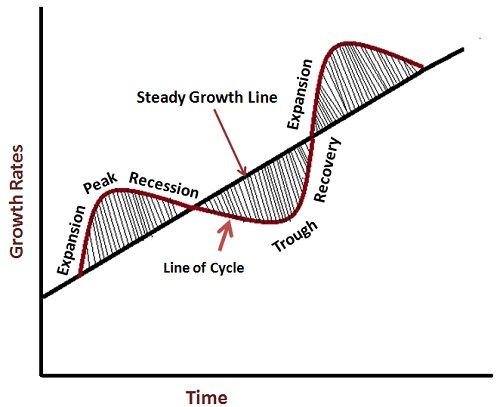Definition: The Business Cycle refers to the ups and downs in the economic activities that the economy experiences over a period of time. Generally, the business cycle is the upward and downward movement in the level of GDP reflected by the fluctuations in the aggregate economic magnitudes Viz. Total production, employment, investment, wages, etc.
Phases of Business Cycle
- Prosperity- Expansion and Peak: In the figure above, the steady line shows the growth of the economy when there is no business cycle. But as soon as the line of cycle moves up the steady line of growth the economy enters into expansion or prosperity phase. The prosperity phase is characterized by increased output, employment, investment, profits, sales, aggregate demand, bank credit, wholesale and retail prices and rise in the standard of living.
In the later stages of prosperity, the inputs start falling short of their demand due to which the price of the inputs, both labor, and raw materials increases. As a result of which the cost of production also increases. With the increase in the price of the goods and services, the households curtail their consumption expenditure, and thus the demand becomes stagnant or declines. This shows that economy has reached its peak. Thus, as long as the situation permits the expansion continues with a multiplier effect, but however the growth rate reaches the peak point and then eventually slows down.
- Turning –Point and Recession: Once the economy reaches the peak it starts slowing down, and the demand declines or becomes stagnant. We can say, that phase of recession begins when the downswing of the growth rate becomes rapid and steady. The recession is characterized by decreased investments, bank credits, stock prices, rise in the unemployment, etc.
The discrepancy between the supply and demand rises as some producers unaware of the recession keeps on producing the commodities. After a point of time, when they realize that their stock is being piled up they believe in being indulged in ‘over-investment’ and ‘over production’. And as a result, they give up their future investment plans, orders placed for raw materials, equipments, and other inputs are canceled. The demand for labor decreases and rather the temporary and casual workers are laid off thereby increasing the unemployment in the economy.
As long as, the growth rate exceeds or is equal to the steady growth rate; the economy is in the phase of prosperity-high or low. But as soon as the growth rate falls below the steady growth rate the economy enters into the depression phase.
- Depression and Trough: The economy reaches the depression phase when the economic activities slide below their normal level. This phase is characterized by a drastic reduction in the national income and other expenditures, prices of consumer goods decline steadily, unemployment increases as workers lose their jobs, bank credit decreases, debtors find difficult to pay off their debts, etc.
When the economy reaches the depth of the depression is said to have reached the trough phase. At this phase, even the expenditure incurred in maintenance is postponed in view of excess production capacity. The weaker firms are weeded out of the market. This marks the end of depression process.
- Recovery and Expansion: During the phase of recovery, some firms either plan additional investments or undertake the renovation programs to come back into the market. With these, the construction activities get a boost in both the consumer and capital goods sector. The individuals who had postponed their plans for constructing the house undertake the task now.As a result of which, more and more employment is generated in the construction sector. As the employment increases the total wage income also increases at a higher rate than the employment rate. Thus, with the rise in the wage income, the consumption expenditure also increases and in return the businessman boost their production to realize higher profits from the sale of their commodities.
Over a period of time, the factors of productions become fully utilized, the wages and the price of other inputs move upward rapidly and investors seek the best alternative investment opportunities. With the increase in the price of inputs, the number of related developments also takes place such as businessmen start increasing their inventories; consumer starts buying more and more durable commodities. Thus, with the process catching up, the economy again enters into the prosperity and expansion phase.
Thus, the business cycle is a continuous process which occurs periodically, more or less in a regular fashion.


Leave a Reply